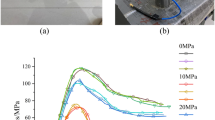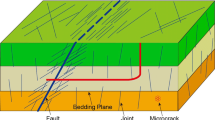Abstract
The continuum-based discrete element method was applied to probe 3D hydrofracturing behaviours. The interaction between hydrofracturing cracks and pre-existing fractures was modelled. Glutenite, a typical heterogeneous rock, was numerically reconstructed using physical parameter tests, computed tomography and imaging processing methods. The effect of pre-existing fractures on hydrofracture propagation was characterized, and the effects of material heterogeneity and horizontal in situ stress differences on fracturing were characterised using fractal theory. Investigation of hydraulic fracture (HF) propagation in heterogeneous rock, and of the mechanism by which complex hydrofracturing crack networks form through numerical simulation, revealed four typical influencing factors. These four, namely mineral particles, in situ stress difference, natural fracture (NF) density, and NF aperture inside the glutenite, were analysed to determine their effect on the HF propagation pattern, and the mechanism of complex fracture network formation in glutenite was determined. A 3D fractal dimension was proposed to characterize the spatial distribution of complex fracture networks. With increasing aperture and density of NFs, the hydrofracturing crack network becomes more complex. Mineral particles hinder the propagation of HFs; analogously, the higher the volume percentage of mineral particles is; the more complex is the hydrofracturing crack network that forms. The HFs generate and propagate near the bilateral tips of the NFs. The HFs will propagate along the direction of maximum horizontal in situ stress, and they are prone to turn into a single crack with greater in situ stress difference. The 3D fractal dimensions were computed and quantitatively reflected the above phenomena.

















Similar content being viewed by others
Explore related subjects
Discover the latest articles, news and stories from top researchers in related subjects.References
Adachi J, Siebrits E, Peirce A, Desroches J (2007) Computer simulation of hydraulic fractures. Int J Rock Mech Min Sci 44(5):739–757
Al-Shayea NA (2005) Crack propagation trajectories for rocks under mixed mode I–II fracture. Eng Geol 81(1):84–97
Al-Shayea NA, Mohib KR (2011) Parameters for an elasto-plasto-damage model for the stress–strain behavior of dense sand. Int J Damage Mech 20(1):63–87
Bieniawski ZT (1967) Mechanism of brittle fracture of rock: part I—theory of the fracture process. Int J Rock Mech Min Sci Geomech Abstr 4(4):395–406
Camones LAM, Vargas ED, Figueiredob RPD, Velloso RQ (2013) Application of the discrete element method for modeling of rock crack propagation and coalescence in the step-path failure mechanism. Eng Geol 153(8):80–94
Charkaluk E, Bigerelle M, Iost A (1998) Fractals and fracture. Eng Fract Mech 61(1):119–139
Chiles JP (1988) Fractal and geostatistical methods for modeling of a fracture network. Math Geol 20(6):631–654
Dahi-Taleghani A, Olson JE (2011) Numerical modeling of multi-stranded hydraulic fracture propagation: accounting for the interaction between induced and natural fractures. SPE J 16(3):575–581
Falconer KJ (1990) Fractal geometry: mathematical foundations and applications. Biometrics 46(4):499
Fan T, Zhang G (2014) Laboratory investigation of hydraulic fracture networks in formations with continuous orthogonal fractures. Energy 74:164–173
Fan T, Zhang G, Cui J (2014) The impact of cleats on hydraulic fracture initiation and propagation in coal seams. Pet Sci 11(4):532–539
Gang W, Ju T (2008) Study of minimum box-counting method for image fractal dimension estimation. In: Paper presented at China international conference on electricity distribution, IEEE Power and Energy Society, Guangzhou, pp 1–5
Hou ZK, Yang CH, Wang L, Liu PJ, Guo YT, Wei YL, Li Z (2016) Hydraulic fracture propagation of shale horizontal well by large-scale true triaxial physical simulation test. Rock Soil Mech 37(2):407–414
Ju Y, Zheng JT, Yang YM (2012) Fractal reconstruction and analysis software of rock pore structures. Software Copyright Registration 2012SR081154, Beijing (in Chinese)
Ju Y, Zheng JT, Epstein M, Sudak L, Wang JB, Zhao X (2014) 3D numerical reconstruction of well-connected porous structure of rock using fractal algorithms. Comput Method Appl Mech Eng 279(9):212–226
Ju Y, Liu P, Chen J, Yang Y, Ranjith PG (2016) CDEM-based analysis of the 3D initiation and propagation of hydrofracturing cracks in heterogeneous glutenites. J Nat Gas Sci Eng 35:614–623
Ju Y, Chen J, Wang Y, Gao F, Xie H (2018a) Numerical analysis of hydrofracturing behaviours and mechanisms of heterogeneous reservoir glutenite, using the continuum-based discrete element method while considering hydro-mechanical coupling and leak-off effects. J Geophys Res Solid Earth 123(5):3621–3644
Ju Y, Wang Y, Chen J, Gao F, Wang J (2018b) Adaptive finite element–discrete element method for numerical analysis of the multistage hydrofracturing of horizontal wells in tight reservoirs considering pre-existing fractures, hydromechanical coupling, and leak-off effects. J Nat Gas Sci Eng 54:266–282
Ju Y, Wang Y, Dong H, Yang Y (2018c) Numerical analysis of the hydrofracturing behaviour of heterogeneous glutenite considering hydro-mechanical coupling effects based on bonded particle models. Int J Numer Anal Meth Geomech 42(13):1493–1515
Lei Q, Wang HY, Zhao Q, Liu DX (2008) Status of and suggestions on the exploration and development of unconventional oil and gas resources in China and elsewhere. Nat Gas Ind 28(12):7–10
Li S, Lian Z, Wang J (2005) Effect of rock mass structure and block size on the slope stability-physical modeling and discrete element simulation. Sci China Ser E Eng Mat Sci 48:1–17
Li LC, Meng QM, Wang SY, Li G, Tang CA (2013a) A numerical investigation of the hydraulic fracturing behaviour of conglomerate in Glutenite formation. Acta Geotech 8(6):597–618
Li LC, Li G, Meng QM, Wang H, Wang Z (2013b) Numerical simulation of propagation of hydraulic fractures in glutenite formation. Rock Soil Mech 34(5):1501–1507
Liang ZZ, Tang CA, Zhang YB, Ma TH, Zhang YF (2006) 3D numerical simulation of failure process of rock. Chin J Rock Mech Eng 25(5):931–936
Liang ZZ, Li LC, Tang SB, Zhang YF (2011) 3D numerical simulation of growth of surface crack of rock specimens. Chin J Geotech Eng 33(10):1615–1622
Liu H, Zhang GH, Zhong SQ, Zhang SQ (2007) Analysis and research on key technologies of hydraulic fracturing. Drill Prod Technol 30(2):49–52
Liu H, Luo TY, Wang JH, Zhao JZ, Zhong YS (2009) Simulation experiment and study of multi-fractures formation in hydraulic fracturing. Drill Prod Technol 32(6):38–40
Liu P, Ju Y, Ranjith PG, Zheng Z, Chen J (2016) Experimental investigation of the effects of heterogeneity and geostress difference on the 3D growth and distribution of hydrofracturing cracks in unconventional reservoir rocks. J Nat Gas Sci Eng 35:541–554
Mohr O (1900) Welche Umstande bedingen die Elastizitatsgrenze und den Bruch eines Materials. Z Ver Dtsch Ing 46:1572–1577
Ozkaya I (1984) Computer simulation of hydraulic fracturing in shales-influences on primary migration. J Pet Technol 36(5):826–828
Peng P, Ju Y, Wang Y, Wang S, Gao F (2017) Numerical analysis of the effect of natural micro-cracks on the supercritical CO2 fracturing crack network of shale rock based on bonded particle models. Int J Num Anal Methods Geomech 41(18):1–23
Qu GM (2008) Several thoughts on the exploration and development of unconventional oil and gas resources. Nat Gas Ind 28(12):1–3
Sato K, Hashida T, Takahashi H, Takahashi T, Hayashi K (1999) Relationship between fractal dimension of multiple microcracks and fracture energy in rocks. Geotherm Sci Technol 36(9):1224–1229
Sato A, Hirakawa Y, Sugawara K (2001) Mixed mode crack propagation of homogenized cracks by the two-dimensional DDM analysis. Constr Build Mater 15(5/6):247–261
Wang L, Li S, Ma Z (2013) A finite volume simulator for single-phase flow in fractured porous media. In: Graham Mustoe (ed) Proceedings of the 6th international conference on discrete element methods and related techniques. States News Service, Golden, pp 130–135
Wang Y, Ju Y, Yang Y (2018a) Adaptive finite element–discrete element analysis for microseismic modelling of hydraulic fracture propagation of perforation in horizontal well considering pre-existing fractures. Shock Vib 2018:1–14
Wang Y, Ju Y, Zhuang Z, Li C (2018b) Adaptive finite element analysis for damage detection of non-uniform Euler-Bernoulli beams with multiple cracks based on natural frequencies. Eng Comput 35(3):1203–1229
Wasantha PLP, Ranjith PG, Shao SS (2014) Energy monitoring and analysis during deformation of bedded-sandstone: use of acoustic emission. Ultrasonics 54(1):217–226
Xie HP (1989) The fractal effect of irregular geometry on crack bifurcation of rock materials. Acta Mech Sin 21(5):613–618
Zhang X, Wu B, Dontsov E, Jeffrey RG, Han Y, Quinlan K (2017). A new pseudo-3D model for hydraulic fracture height growth in multilayered rocks. In: 51st US rock mechanics/geomechanics symposium. American Rock Mechanics Association. ARMA-2017-0572
Zhao YZ, Cheng YF, Qu LZ, Wang JY, Shen HC (2007a) Finite element simulation of dynamic fracture in hydraulic fracturing. Acta Pet Sin 28(6):103–106
Zhao YZ, Qu LZ, Wang XZ, Cheng YF, Shen HC (2007b) Simulation experiment on propagation law of hydraulic fracture for different lithologic formations. J China Univ Pet (Nat Sci Ed) 31(3):63–66
Zhao LQ, Xing YY, Liu PL, Xing YM, Gong YL (2013) A study on the pattern of initiation of hydraulic fractures in horizontal wells in various tectonic strata. J Oil Gas Technol 35(5):108–114
Zhao LQ, Liu F, Wang PS, Liu PL, Luo ZF, Li NY (2014) A review of creation and propagation of complex hydraulic fracture network. Oil Gas Geol 35(4):562–567
Zhou Z, Zhang G, Dong H, Liu Z, Nie Y (2017) Creating a network of hydraulic fractures by cyclic pumping. Int J Rock Mech Min Sci 97:52–63
Zhou D, Zhang G, Zhao P, Wang Y, Xu S (2018) Effects of post-instability induced by supercritical CO2 phase change on fracture dynamic propagation. J Pet Sci Eng 162:358–366
Acknowledgements
The authors gratefully acknowledge the financial support received from the National Major Project for Science and Technology [Grant no. 2017ZX05049003-006], the State Key Research Development Program of China [Grant no. 2016YFC0600705], the National Natural Science Foundation of China [Grant nos. 51674251, 51727807, 51874309, 41877275, 51608301, 51374213], and Innovation Teams of Ten-thousand Talents Program sponsored by the Ministry of Science and Technology of China (2017).
Author information
Authors and Affiliations
Corresponding author
Ethics declarations
Conflict of interest
The authors declare that they have no conflict of interest.
Rights and permissions
About this article
Cite this article
Li, F., Yang, Y., Fan, X. et al. Numerical analysis of the hydrofracturing behaviours and mechanisms of heterogeneous reservoir rock using the continuum-based discrete element method considering pre-existing fractures. Geomech. Geophys. Geo-energ. Geo-resour. 4, 383–401 (2018). https://doi.org/10.1007/s40948-018-0095-5
Received:
Accepted:
Published:
Issue Date:
DOI: https://doi.org/10.1007/s40948-018-0095-5




